Crisis com': return to the bad buzz world of which had been victim Dior a few years ago, and to analyze how the brand was able to brilliantly manage its crisis communication.
Note: This chapter, originally published in 2012 and republished in 2023, is the 11th in a series of course on Social Media, the summary of which can be found here.
Intro: a double performance for Dior
If I want to come back to this issue, it is because it has become a sort of textbook case in the very cruel world of bad buzz. Indeed, the Dior house not only knew how to communicate around this affair, but it also used the bad buzz to its advantage, and it is this double success that allowed him to perform. To fully understand the reasoning, we will see why John Galliano could, in his genius, constitute a certain “burden” for Dior, before we set about analyzing the management of the crisis by the brand and the opportunism it demonstrated .
This file is inspired by a mini-dissertation on Crisis Communication submitted to the faculty of the University of Paris 1 Panthéon-Sorbonne.
Dior and John Galliano
Galliano, genius of haute couture
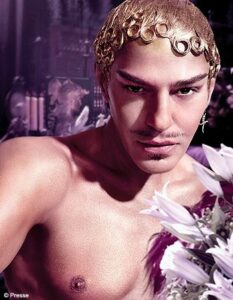 Before being the plague we know today (on a media level, I mean), John Galliano was considered a true genius in the world of haute couture.
Before being the plague we know today (on a media level, I mean), John Galliano was considered a true genius in the world of haute couture.
Of Italian-Spanish origin, he began his studies at the prestigious St. Martin's College Art and Design in 1981, before making a name for himself with his first fashion show "Les incredibles", whose dress codes were inspired by the Revolution French.
After receiving the British Designer's Prize in 1987, Galliano continued his rise, which included Paris, the fashion capital, until his appointment as head of the prestigious house Dior.
An invaluable contribution to the house of Dior
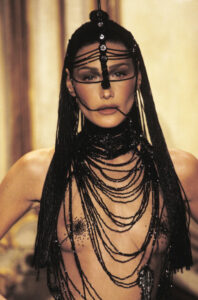 Upon his arrival at Dior, John Galliano revitalized the brand by replacing its image, which was intended to be traditional and classic, with a more glamorous and trendy touch.
Upon his arrival at Dior, John Galliano revitalized the brand by replacing its image, which was intended to be traditional and classic, with a more glamorous and trendy touch.
In addition to being the artistic director of all Dior women's collections, he was named responsible for the overall image of Dior in 1999. His new communications functions allowed him more freedom: he, in a way, made the brand his own. , which then clearly reflects his personality, information which is important for the rest of the events.
Its whimsical and extravagant side leads Dior to present original collections, drawing inspiration from the Maasai women in 1997, from Japan for the spring-summer 2007 collection, or even from the 1950s for its fall-winter 2008-2009 collection...
By mixing eccentricity and elegance, Galliano brings invaluable know-how and image to the Dior brand.
Full powers
Given his extraordinary popularity, the Dior house gave him responsibilities as a creator. Except that Galliano took over the brand and gradually supplanted it with his own name.
If rumors about his capricious attitudes and his mental health became more frequent, his popularity reached peaks between 2000 and 2010, depending on the hard blows he suffered, notably the deaths of several of his close friends.
In 2007 he obtained the Crystal Globe best fashion designer. In January 2009 he was promoted to Knight of the Legion of Honor. At the start of 2011, he was considered a true fashion icon, as respected for his talent as mystified for his moods and addictions.
An unpredictable personality
While he is considered one of the most renowned and influential designers of his generation with Karl Lagerfeld and JP Gautier, Galliano is also a media personality: his provocative looks and his escapades give him a narcissistic image. , provocative and eccentric. As proof, his creations are inspired by taboo subjects, notably in 2000 when his fashion show “les clochards” defied the headlines, but still earned him worldwide success.
His turbulent and eccentric personal life certainly raises some questions, but does not alert the Dior house to a possible slippage. Furthermore, Dior's new image is not only nourished by the talent and notoriety of John Galliano, but also by his media escapades.
Therefore, the brand may have decided to turn a blind eye to the stylist's internal whims and mood swings.
The Galliano scandal: the facts
The first complaints
Complaint of February 24, 2011
On the evening of February 24, 2011 on the terrace of a Parisian café, John Galliano, under the influence of alcohol, had an altercation with two individuals, and was the subject of a complaint for minor violence and racist and anti-Semitic insults. . However, Galliano denies the facts outright and in turn files a complaint for insults and defamation. On February 25, 2011, the next day, Dior reacted promptly by suspending John Galliano pending the end of the investigation.
Complaint of February 26, 2011
A few days later, another woman came forward and claimed that John Galliano had uttered racist insults towards her on October 8, 2010. Two complaints are now subject to examination by the High Court.
John Galliano's shocking and racist video
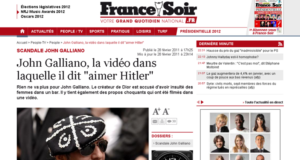 Then came the twist. A video revealed on February 28, 2011 by the British newspaper The Sun features the famous fashion designer visibly drunk and making racist and anti-Semitic remarks. Dating from December 2010, this video, which has received hundreds of thousands of views around the world in just a few hours, tends not only to strengthen the credibility of the two complaints on a judicial level, but also in the eyes of public opinion, which discovers the hidden face of John Galliano, to the great dismay of the house of Dior, then faced with a huge spotlight that was harmful to its image.
Then came the twist. A video revealed on February 28, 2011 by the British newspaper The Sun features the famous fashion designer visibly drunk and making racist and anti-Semitic remarks. Dating from December 2010, this video, which has received hundreds of thousands of views around the world in just a few hours, tends not only to strengthen the credibility of the two complaints on a judicial level, but also in the eyes of public opinion, which discovers the hidden face of John Galliano, to the great dismay of the house of Dior, then faced with a huge spotlight that was harmful to its image.
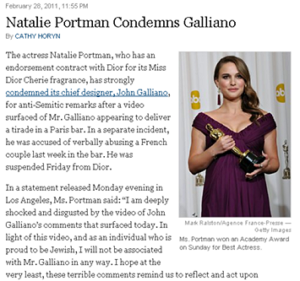 This incident provoked numerous reactions from personalities linked to the house of Dior.
This incident provoked numerous reactions from personalities linked to the house of Dior.
Natalie Portman, famous international actress and new face of Dior perfumes, publicly and firmly condemns John Galliano's comments in a press release sent to The New York Times newspaper:
“I am deeply shocked and disgusted by John Galliano's comments on this video released today. In light of this video and as a proud Jew, I refuse to be associated with Mr. Galliano in any way. I hope that at least these terrible comments remind us how important it is to fight and act against these still existing prejudices, which are the exact opposite of everything there is. beautiful. »
Dior's reaction
1er March, the house of Dior publishes a press release announcing the dismissal of John Galliano with an immediate layoff. Additionally, CEO Sidney Toledano says he condemns “most firmly the statements made by John Galliano, which are in total contradiction with the essential values which have always been defended by the House of Christian Dior. »
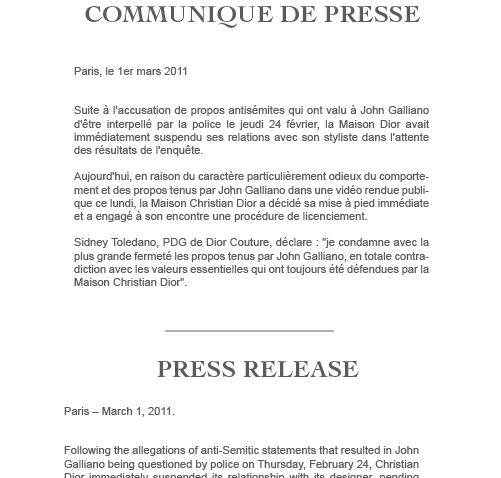
Finally, on September 8, 2011, John Galliano was sentenced to a €4,000 suspended fine for the incident that occurred on February 24, 2011, and a €2,000 fine for the previous incident that occurred in October 2010 by the court. Paris Correctional Facility.
He must also pay €16,500 in legal costs and a symbolic amount of €1 in damages to the three individuals (including a couple) as well as to five anti-racist associations which have joined as civil parties.
Analysis of crisis management and communication by Dior
The context preceding the crisis
A precedent: the Guerlain affair
Guerlain, like Dior, is a subsidiary of LVMH. However, on October 15, 2010, perfumer Jean-Paul Guerlain slipped up on the 1 p.m. television news on France 2, making racist comments.
This episode is in this case infamous for the late reaction on the part of the LVMH group, which took more than a week to issue a simple formal press release recalling that the group firmly condemns all forms of racism. If we add to this slippage that of John Galliano a few months later, the sum of the controversies which follow one another takes on a much greater weight, which leads the companies Dior, Guerlain and their parent company to enjoy a much less glamorous and impeccable than they pretend to be.
However, unlike the Guerlain case, Dior reacted very quickly to the crisis. John Galliano is immediately suspended pending the end of the investigation, before Sidney Toledano, president of Dior Couture, claims “with the greatest firmness its policy of zero tolerance towards any anti-Semitic or racist remarks or attitudes ".
A weight constraint: a Dior fashion show planned for March 4, 2011
It is clear that in this crisis, Dior has come a long way. In the middle of Fashion Week, John Galliano was to host a show at the Rodin Museum. The stylist will ultimately not be present, having been sidelined in the meantime by Dior.
The advent of viral information and videos: vector of “bad buzz” for Dior
There is a world of difference between the way these kinds of scandals emerge today compared to before. Several factors contribute on the one hand to an intensification of word of mouth and the mass of information communicated, and on the other hand to an increase in the speed of communication:
- The development of smartphones that capture any slippage (the famous “Casse-toi pauv'con” of President Nicolas Sarkozy was one of the most striking examples).
- The advent of social networks, which gave rise to the boom in so-called viral information, and digital content generated by Internet users, since everyone becomes, in a way, their own media, reporting and criticizing as they see fit the information that comes to them. succeed.
- The temptation for digital media to treat shocking news in order to take advantage of this viral potential, although in this case, the French press did not want to buy Galliano's video to broadcast it.
Taking into account this new context, this crisis at Dior requires new skills to be managed. Starting with the publication on the Internet of press releases intended to prevent or cure the ills caused by John Galliano on the brand, then by the establishment of “community managers” responsible for digital monitoring to process what is said and be able to do so. respond intelligently.
A unique bar-restaurant: La Perle
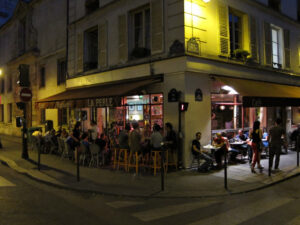 This element of the Dior crisis, although a point of detail, has a relative importance on a symbolic level when we know the history of this place, located in 3th district of Paris.
This element of the Dior crisis, although a point of detail, has a relative importance on a symbolic level when we know the history of this place, located in 3th district of Paris.
Indeed, the bar where the altercation took place, and which subsequently turned out to be the epicenter of all of Galliano's other excesses, is known to be - in the evening - one of the meeting points in all of Paris “bobo” and trendy: models, creators, stylists, model makers, designers, and public figures rub shoulders, in a very relaxed and warm atmosphere.
By its nature, this place crystallized the slippage of John Galliano in the world of fashion, since this bar is at the center of fashion in Paris.
Post-slip management
Dior's bundle of cues and reactivity
Where other controversies may have been suppressed, the Galliano affair took a turn that was more difficult to control once a dazzling domino effect began. After the first complaint, it is still possible for Dior management to cover up the affair by not dwelling too much on it, because at that moment, in the eyes of the general public, no one knows whether the accusation made by the alleged victim is founded.
Moreover, at the moment when the complaint was filed against him, John Galliano opted for the following strategy: discredit the attacks by filing a complaint in turn for insults and defamation, and declaring that he himself had been verbally attacked while playing thus “word against word”.
But the tenacity of the alleged victim pushes her to testify to the press the next day, and to recount in detail the comments made by the designer. Europe 1 puts the testimony online, which does not help Dior's business in any way, since the controversy is growing. However, Dior will not procrastinate for very long to make a firm decision against its designer.
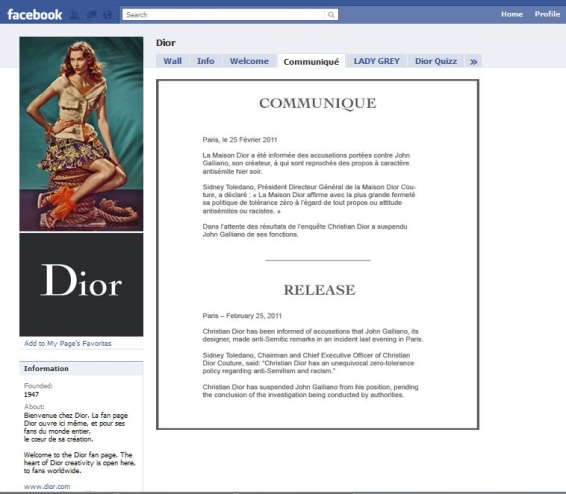
Unlike the Guerlain crisis, and while John Galliano is entangled in a silent, confused and denial communication strategy, Dior is extremely responsive to this crisis, by responding tit for tat to the events that follow one another with skillful decisions:
- Galliano's suspension following the complaint puts the management of Dior a step ahead in terms of its credibility and its dissociation from the behavior of its artistic director. However, at that time management had no certainty about Galliano's responsibility, and clearly lacked information.
- The dismissal and immediate layoff of Galliano following the video revealed by The Sun.
- The choice to publish press releases announcing his suspension and then his dismissal on Dior's Facebook page.
The response was not only swift and clear, it was also firm and ruthless. On March 3, L'express reported that references to John Galliano on the Dior website were gradually being removed. For example, “The Massai necklace inspiration, imagined by John Galliano” and which we talked about at the start of this press review, becomes “The Massai necklace inspiration” on the site.
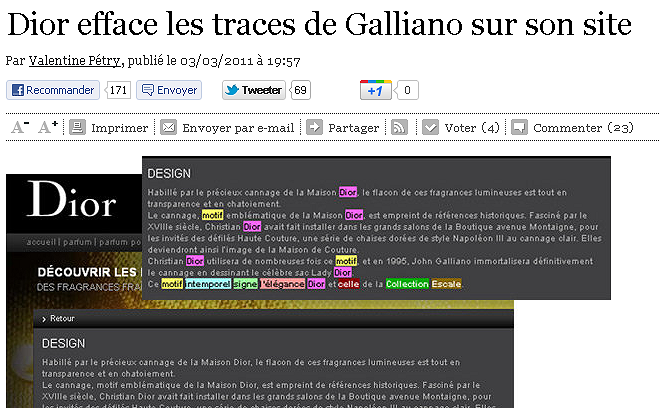
Finally, Dior decides to maintain the John Galliano show scheduled for March 4, 2011, but without his presence, and hastening to remove all references to his name. During this event, Sidney Toledano plays the transparency card, evoking three major ideas.
The first one, is that he speaks of a “test” for Dior. The opposite of the strategy of denial, this position has the merit of reassuring stakeholders that leaders are taking into account the importance of the crisis.
Then, he gives Galliano back his letters of nobility, which shows that Dior has the honesty of recognizing the creative and talented contribution of your designer, before denounce the “unacceptable remarks” of which the stylist was guilty, which has constituted the basis of Dior's communication strategy for this crisis from the start.
By playing this card of transparency and zero tolerance, Dior management was able to manage the crisis brilliantly. Thomas Serrano, director of the luxury branch of Euro RSCG, praised the speed and foresight of Bernard Arnault, owner of LVMH, and described this management as a “crisis model”.
On March 4, just after Dior parted ways with John Galliano, LVMH stock was up 0.26 1TP3Q. “The financial community has praised the responsiveness of the LVMH group”, commented Emmanuel Bruley des Varannes, financial analyst specializing in luxury at Société Générale.
The “bad buzz” effect and bottom line
Proof that effective crisis management does not stop when the media fire seems to be extinguished, a video dating from 1963 appears on the web via the INA website and in which we can see Françoise Dior, niece of the founder from the haute couture house, apologizing for Hitler and Nazism.
Keen to exploit the Dior saga to the end, the media relayed the video, while scrupulously recalling that Françoise Dior was never closely or remotely associated with the Dior house, which proves the good communication upstream of the brand, which although continuing to be exposed to digital scraping, remains relatively dissociated from this “bad buzz” in the eyes of the public and the press.
A crisis transformed into an opportunity for Dior
No one is fooled, the company's unequivocal distancing from its stylist was not a painful heartbreak for Dior.
First of all, in a note dated December 28, 2010 and reported by Le Parisien-Today in France in May 2011, the brand declared that it was “for several years, regularly informed of serious incidents linked to Mr. Galliano's alcoholism (…) He would not have responded to several requests for meetings launched by Bernard Arnault, main shareholder of the Christian Dior company”.
Another note reports that the group's leaders also said about John Galliano: “it becomes unbearable and unmanageable also for the teams who work with him. (…) The financial and human stakes are too important.”
It therefore seems that Dior seized the opportunity of this crisis to transform it into an opportunity. The objective: to renew the Dior style to be more in line with the new, more discreet and wiser fashion codes, and to dismiss at a lower cost a designer who had become unmanageable.
As such, a marketing professor at ESCP confides to Monde.fr his analysis of the situation, which is completely in line with Dior's opportunistic exploitation of the Galliano scandal:
“For me, the real question is whether this dismissal is linked to Galliano's comments or whether it is just an excuse to get rid of him. It is very complicated for a stylist to stay creative when you have worked for the same brand for more than 15 years. We can say that Galliano had done his time at Dior. Furthermore, it seemed that due to personal problems he was working less than before. In my opinion, the company made a marketing stunt to get rid of it in a clever way, which also allows him to defend ethics. It's a opportunistic gesture on the part of a brand. »
Furthermore, fashion specialists agree that Dior has for some time wanted to reconnect with the aesthetics and values that made it successful during the time of its creator Christian Dior. However, Galliano's too young artistic style and flashy notoriety no longer entered into Dior's strategy, which could then have looked for a way to oust him. His shock and anti-Semitic slip was therefore timely.
Conclusion: responsiveness, honesty, opportunism
This case of crisis communication has become a model of its kind. And for good reason, Dior was able to combine three fundamental behaviors to be able to manage a crisis marked by the evolution of web 2.0: responsiveness, honesty and opportunism (even cynicism).
For each major event, Dior reacted the next day. In his reactions, the company has assumed its share of responsibility, all in breaking away from the departure of John Galliano. Finally, Dior knew take advantage of the crisis to start again on a new basis of stylistic creation. In other words, you have to know how to put on the table all the options you have, even those which are least in line with the overall strategy of the company (I am thinking in particular of the marketing target), and choose the one from which we can benefit, even if it means changing tack!
This textbook case shows that, unlike strategies based on denial and waiting for information to act, ethics, anticipation and tactics can be skillfully balanced in order to emerge unscathed or even enhanced from a crisis situation.
I initially wrote this file as part of a Crisis Communication mini-dissertation at Paris 1 Panthéon-Sorbonne. Don’t hesitate to use it for your possible work but remember to leave a little message of thanks in the comments if it was useful to you 😉
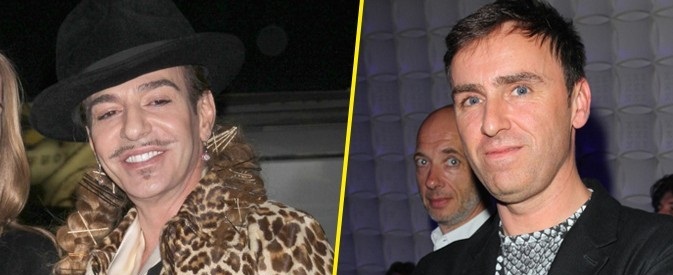


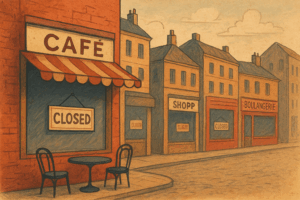
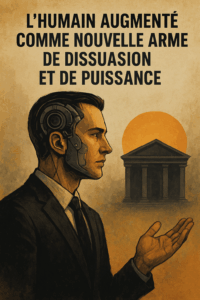


8 Responses
Great file, it was really very useful for me in writing an essay. Thank you very much 🙂
No wonder, thanks for the comment! 😉
It's very interesting indeed, on the other hand, I who had been following Galliano since 2000, which is to say 10 years, the last Dior couture show was distressing. Succeeding in communicating and saving the furniture is good, even if you have to come up with new ones that hold up, on the creation side it's less successful for once. Basically Galliano had overtaken Dior and that was annoying LVMH.
Good analysis. I admit that your research clarifies all the elements that must be brought together to manage a crisis situation.
Thank you for this very clear analysis!
Thank you very much for this article which helped us a lot for our English marketing course!
Thank you for this article, it allowed me to make links for my end-of-study work!
Article used for my courses on crisis communication which illustrates both good practice and the excesses of too much personification of companies with their manager. THANKS